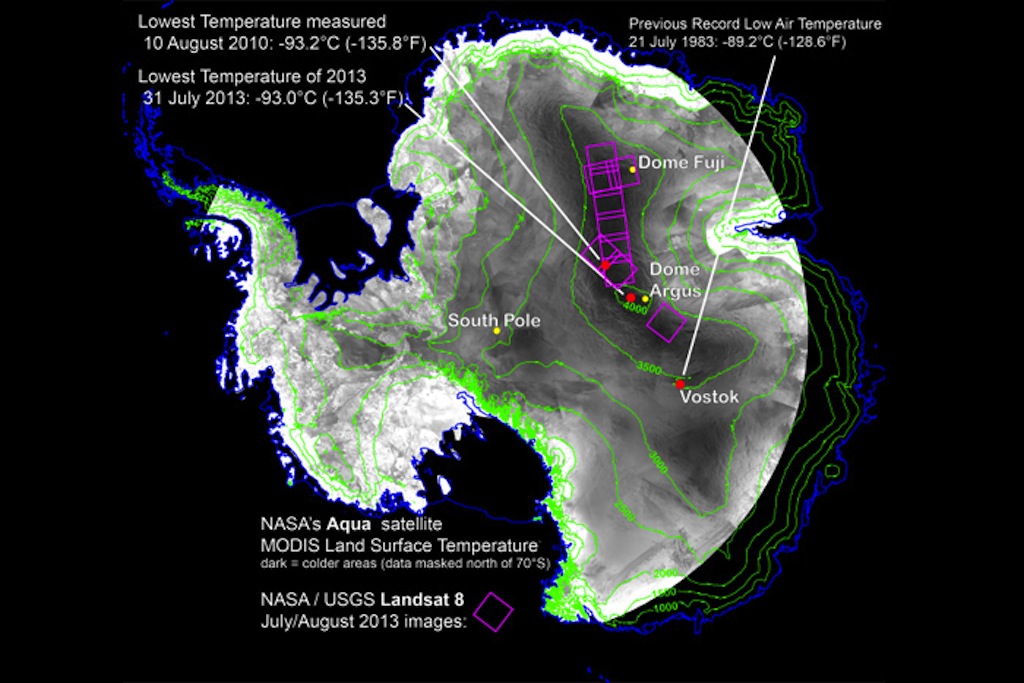Coldest Places on Earth Found, In Antarctica, Of Course

SAN FRANCISCO — Where is the coldest temperature ever measured on Earth?
"It's in Antarctica of course," Ted Scambos, lead scientist at the National Snow and Ice Data Center in Boulder, Colo., said here today (Dec. 9) at the annual meeting of the American Geophysical Union.
That temperature? A mind- — and body-numbing — minus 136 degrees Fahrenheit (minus 93.2 Celsius), measured in pockets scattered near a high ice ridge between Dome Argus and Dome Fuji, two summits on the East Antarctic Plateau.
The temperature measurement came from the most detailed global surface-temperature maps made to date, which were created using data from the new Landsat 8 satellite, launched in February, and 32 years' worth of data from the Moderate Resolution Imaging Spectroradiometer (MODIS) instruments on NASA's Terra and Aqua satellites and instruments aboard several other satellites.
Researchers began looking at these frigid pockets after they noticed cracks in the snow between large snow dunes on the plateau and wondered if super low temperatures might be creating the cracks by causing the snow on the surface to shrink. This led them to begin the search for the coldest places on the planet. [In Photos: The Coldest Places on Earth]
Cold, colder, coldest
They turned to the temperature records from the satellites, whose instruments measure the thermal radiation emitted at Earth's surface. The coldest temperature they found occurred on Aug. 10, 2010 (winter in the Southern Hemisphere). The temperature is essentially the same "as if you were to take your hand and put it on the surface of the snow. I don't recommend that, as, in this case, that would be colder than dry ice," Scambos said. It's "50 degrees colder than anything that has ever been seen in Alaska, or Siberia," he added.
Get the Space.com Newsletter
Breaking space news, the latest updates on rocket launches, skywatching events and more!
The temperatures in these pockets are able to drop so very, very low thanks to a combination of circumstances. Scambos and his colleagues think the stage is set for these record lows when clear skies above the domes cause the air to get colder as it radiates heat away to space. As the air near the Earth's surface gets colder, it also gets denser, and begins sliding down the dome, until it encounters one of these pockets, where it can become stuck. As it sits there possibly over several days, the air keeps radiating away heat and becomes colder and colder, until it reaches the record lows observed by the satellites.
The researchers think the air gets stuck on its way down the dome and toward the coast of the continent when atmospheric patterns conspire to "try to push the air back uphill," Scambos said.
Interestingly, the coldest temperatures measured in these pockets were all within a degree or two of each other, suggesting a potential floor to just how low the temperature can go.
"It's surprising that all of those places would have so similar a record," Scambos said.
The similarity could be explained in a few ways, he said: Thin clouds that form in the Earth's stratosphere (the layer of the atmosphere above the one humans live in and in which most weather occurs) could be limiting how much heat the air is able to radiate away into space. Or it could be that the weather systems that block the air only last for so long, among other possibilities. [Video: Coldest Place on Earth Found]
Scambos and his team are planning to use Landsat 8's capabilities to examine the surface with a higher resolution than previous satellites to better understand the cold pockets and to nail down more accurately the exact temperatures reached in them.
No official record
The temperatures won't make it into the official record books though, since the World Meteorological Organization recognizes only temperatures made a couple of meters above the surface. The long-standing record for the coldest temperature by that measure was, of course, also in Antarctica, at the Vostok Research Station, where it reached minus 128.6 F (minus 89.2 C) in July 1983.
However, Scambos is certain that if one could measure the air temperature at the proper height in these cold pockets — which would be hard because a mercury thermometer wouldn't work in such extremes, and an alcohol thermometer would be hard pressed — that they'd have Vostok beat.
"I'm confident the pockets are the coldest places on Earth," Scambos said. "I wouldn't be here if I wasn't pretty sure we were colder than Vostok."
Follow Andrea Thompson @AndreaTOAP, Pinterest and Google+. Follow OurAmazingPlanet @OAPlanet, Facebook and Google+. Original article at LiveScience's OurAmazingPlanet.
Join our Space Forums to keep talking space on the latest missions, night sky and more! And if you have a news tip, correction or comment, let us know at: community@space.com.

Andrea Thompson is an associate editor at Scientific American, where she covers sustainability, energy and the environment. Prior to that, she was a senior writer covering climate science at Climate Central and a reporter and editor at Live Science, where she primarily covered Earth science and the environment. She holds a graduate degree in science health and environmental reporting from New York University, as well as a bachelor of science and and masters of science in atmospheric chemistry from the Georgia Institute of Technology.










